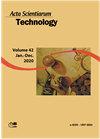葡萄渣生物活性成分及抗氧化活性的探索性分析
IF 0.6
4区 综合性期刊
Q3 MULTIDISCIPLINARY SCIENCES
引用次数: 2
摘要
采用分光光度法、色谱法、光谱学等方法对梅洛葡萄渣中的酚类成分及其抑菌活性进行了研究。此外,通过主成分分析(PCA)评估了酚类化合物与抗氧化活性之间的相关性。根据DPPH(2.58±0.07 mg mL-1)、系统β-胡萝卜素/亚油酸自氧化(70.60±0.91%)、ABTS(1.22±0.01 mg mL-1)和FRAP(23.83±0.64µM FeSO4 g-1)测定,梅洛葡萄渣中含有具有较高抗氧化活性的酚酸、黄酮类化合物和二苯乙烯类化合物。提取物对革兰氏阳性菌和革兰氏阴性菌的抑菌浓度最低,对蜡样芽孢杆菌(MIC = 12.5 mg mL-1)和金黄色葡萄球菌(MIC = 25 mg mL-1)的抑菌浓度最高。此外,中红外光谱还发现了酚类化合物的指纹图谱,支持了色谱分析的结果。通过主成分分析,抗氧化电位测定结果与酚类成分有较高的相关性。因此,考虑到梅洛葡萄渣中发现的不同生物活性化合物的显著浓度,可以推断,这种廉价的副产品可以被食品工业在开发新产品时重复使用本文章由计算机程序翻译,如有差异,请以英文原文为准。
Exploratory analysis of bioactive compounds and antioxidant potential of grape (Vitis vinifera) pomace
The aim of this study was to explore the profile of bioactive compounds of Merlot grape pomace by different methodologies including phenolic composition by spectrophotometry, chromatography and spectroscopy and its antibacterial activity. Additionally, the correlation between phenolic compounds and antioxidant activity by principal component analyses (PCA) was evaluated. Merlot grape pomace showed different classes of bioactive compounds such as phenolic acids, flavonoids and stilbene with high antioxidant activity according to the DPPH (2.58 ± 0.07 mg mL‑1), autoxidation of system β-carotene/linoleic acid (70.60 ± 0.91%), ABTS (1.22 ± 0.01 mg mL-1) and FRAP (23.83 ± 0.64 µM FeSO4 g-1) assays. The extracts showed minimum inhibitory concentration for gram-positive and gram-negative bacteria with high values for Bacillus cereus (MIC = 12.5 mg mL-1) and Staphylococcus aureus (MIC = 25 mg mL-1), respectively. In addition, fingerprint regions of the phenolic compounds were found by mid-infrared, supporting the results of the chromatographic analyses. Through the PCA, the antioxidant potential assays had high correlation with phenolic composition. Therefore, considering the significant concentrations of the different bioactive compounds found in Merlot grape pomace, it can be inferred that this cheap by-product can be reused by the food industry in the development of new products
求助全文
通过发布文献求助,成功后即可免费获取论文全文。
去求助
来源期刊

Acta Scientiarum-technology
综合性期刊-综合性期刊
CiteScore
1.40
自引率
12.50%
发文量
60
审稿时长
6-12 weeks
期刊介绍:
The journal publishes original articles in all areas of Technology, including: Engineerings, Physics, Chemistry, Mathematics, Statistics, Geosciences and Computation Sciences.
To establish the public inscription of knowledge and its preservation; To publish results of research comprising ideas and new scientific suggestions; To publicize worldwide information and knowledge produced by the scientific community; To speech the process of scientific communication in Technology.
 求助内容:
求助内容: 应助结果提醒方式:
应助结果提醒方式:


